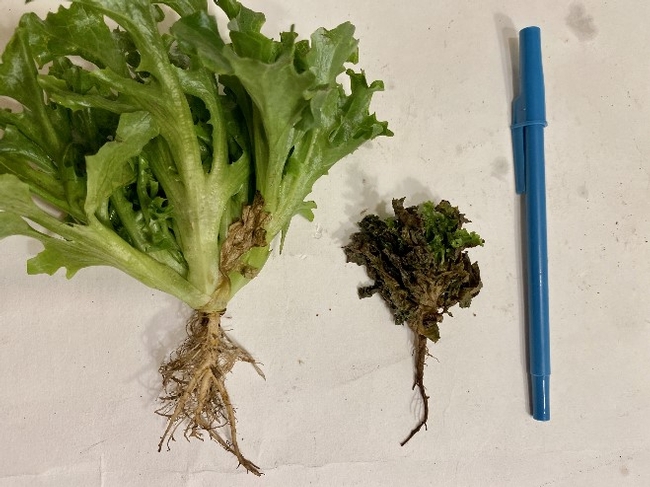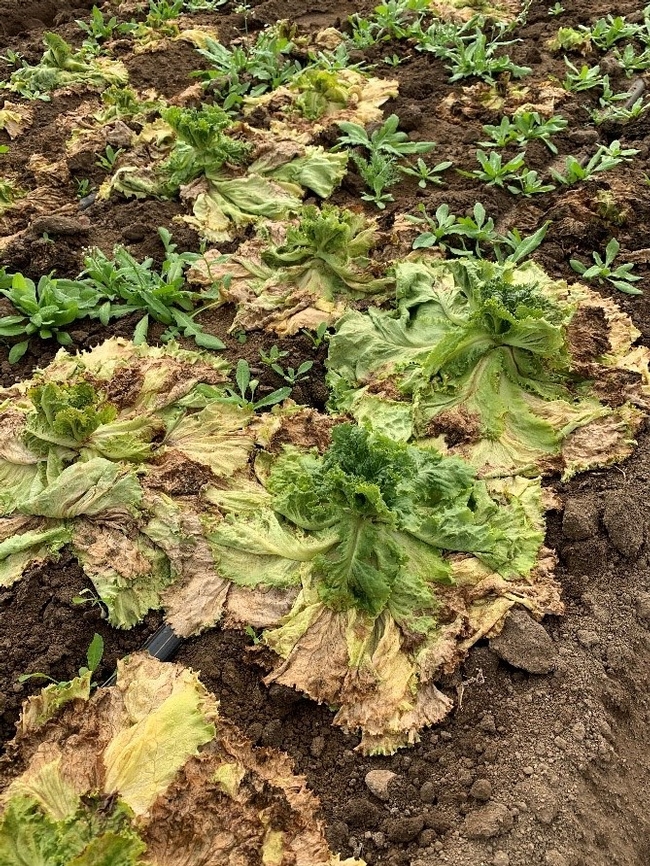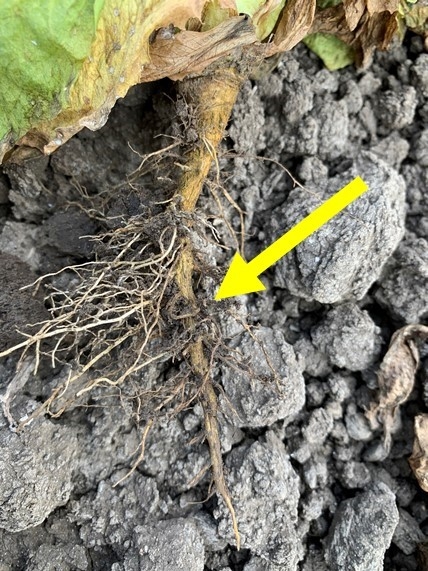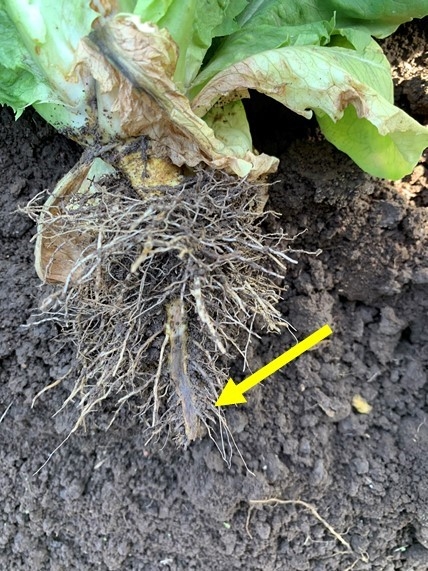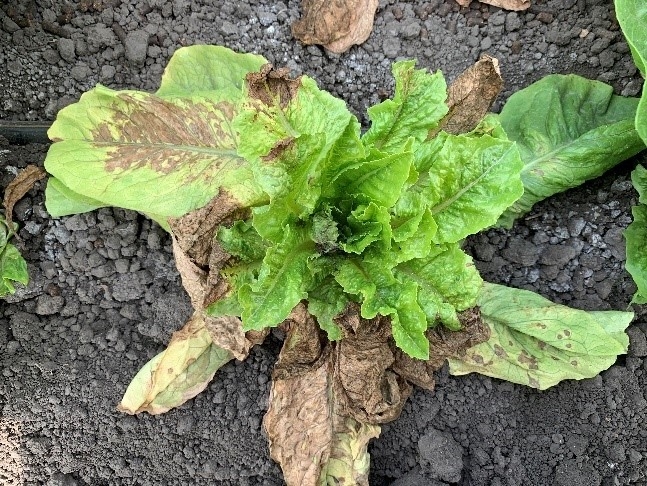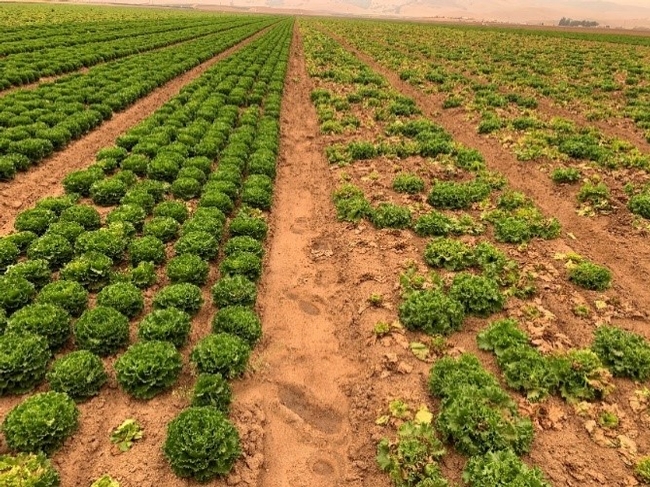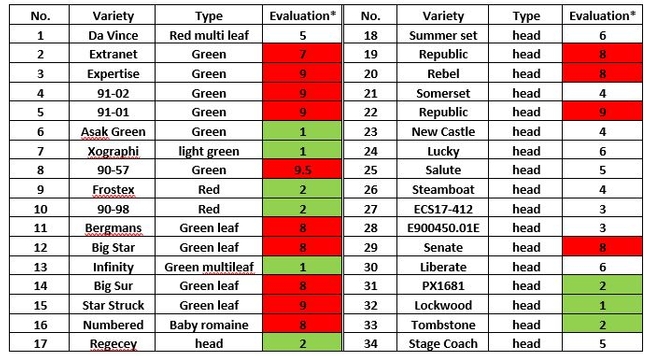Strategies to Control Pythium Wilt of Lettuce
Author: Richard Smith and JP Dundore-Arias
Farm Advisor, UCCE Monterey; and Plant Pathology Professor, Cal State Monterey Bay
In 2020 Pythium wilt of lettuce (Pythium uncinulatum) caused up to 100% yield loss in some fields in the Salinas Valley. Although, Pythium wilt has been present in the Salinas Valley for nearly a decade, the widespread severity of the outbreaks this year were devastating and unprecedented.
Symptoms of the above ground parts of the plant include stunting, yellowing, and wilting of the outer leaves and eventual death (Photo 1). Sometimes the plants have a characteristic look where the younger leaves remain upright, but the older leaves wilt down (Photo 2). Upon examination, the roots of Pythium wilt infected plants, exhibit rot on the feeder (Photo 3) and/or the tap roots (Photo 4). The crown of the plant does not rot (however, in advanced infections the whole length of the root may be rotted) and this is one way to distinguish Pythium wilt from Sclerotinia. For instance, when you gently tug on wilting plants, Pythium infected plants do not break off at the soil line, whereas plants infected with Sclerotinia readily break off at the soil line and exhibit characteristic white mycelia and black sclerotia. The presence of rot on the roots distinguishes Pythium wilt from Verticillium and Fusarium wilts which cause internal vascular discoloration, but not external rot. If you are unsure about the cause of wilting/dying plants, it is best to have them tested.
Pythium wilt infects lettuce roots with swimming spores (zoospores) that move to the roots in soil water films. Additionally, it produces a second type of spore (oospore) that allow long-term survival in the soil. Moreover, Pythium species are generally known as good soil saprophytes, characterized for their ability to grow and survive in the soil even in the absence of a host plant by living on organic matter. Previous studies have reported P. uncinulatum is a pathogen of lettuce and does not cause disease on other vegetable crops. However, it remains unknown whether rotations with other crops may contribute to a build-up of the pathogen in the soil.
Devastating outbreaks of Pythium wilt mostly occurred on the east side of the Salinas Valley north of Gonzales on decomposed granite soils, but outbreaks also occurred in clay loam and sandy loam soils along the river. Given that Pythium wilt is a water mold, it was often most severe in wetter parts of the field with slower drainage, such as the bottom end of the field. However, in severe infestations Pythium wilt occurred the entire length of the field, particularly on susceptible varieties.
It is not clear what might have triggered the disease outbreaks, but widespread infections occurred following heat spells in mid-August and early-September. It is not clear why the heat may have triggered the outbreaks, but it is possible that additional irrigation water applied to cope with the heat could have imposed additional stress on plants with already unhealthy root systems. However, this explanation is not entirely satisfactory as smaller outbreaks were also observed in June and July prior to heat spells.
Pythium wilt infections frequently occurred in association with Impatiens Necrotic Spot Virus (INSV) infections. In trial 5, 8.4% of the plants had Pythium wilt and nearly all of them,7.9%, were also infected with INSV (Table 2, Photo 5). However, this was not always the case; in trial 4, plants with symptoms of Pythium wilt occurred on 22.6% of the plants, but only 0.8% were infected with INSV. Coinfection with Sclerotinia, Fusarium and Verticillium also commonly occurred.
Fungicide Trials
In late September, we conducted Pythium wilt control trials in commercial fields. Each trial consisted of areas treated with 2-pints/A of Ridomil Gold which was compared with an untreated control. Ridomil Gold is registered for use on lettuce for at-planting soil applications to control damping off caused by Pythium sp. These trials were initiated too late in the planting season to include at-planting treatments, so Ridomil was applied at the following timings: 2 true leaf stage (one trial), at thinning (2 trials) and at the rosette stage (3 trials) (See Table 1 for more details).
In trials 2 and 3 we measured a significant reduction in the number of plants per plot that showed symptoms of Pythium wilt (Tables 3 and 4); no significant reduction in infected lettuce plants was observed in the other four trials. These trials showed that Ridomil applied at thinning and at the rosette stages could provide limited control of Pythium wilt. The best control was observed in the at-thinning application in Trial 3. It is not clear why Ridomil did not provide better control in the other four trials. We did not have the opportunity to examine at-planting applications in this year's trials, but they will be examined in 2021. Pythium wilt affects feeder roots on lettuce plants which are higher up in the soil profile, but it has also been commonly observed to attack that tap root of lettuce indicating that the infections can start deeper in the soil profile. Ridomil is mobile in soil which should allow it to distribute throughout the root zone. Questions remain regarding improving the efficacy of Ridomil: what are the effective rates, what is the most efficacious timing of application and can split applications improve efficacy?
Varietal Resistance
There were significant differences in the susceptibility of varieties to Pythium wilt. Table 5 shows the results of ratings of varieties in several commercial production fields and one seed company variety trial. The evaluations were made at or near crop maturity and the lower numbers indicate less infection. None of the varieties were completely resistant to Pythium wilt, but several had greater tolerance. In general, the red leaf types were more tolerant than green leaf types, but there were some green leaf types that were tolerant as well (Photo 4). There were several head types that were also tolerant, but no tolerant romaine lettuce types were observed.
It is unclear if Pythium wilt will be a recurring threat to lettuce production in 2021. As mentioned, in 2020 the widespread incidence of the disease occurred in late summer. Pythium wilt was observed to a lesser extent in the spring of 2020 and the question whether it will cause widespread infection in the cooler months of 2021 is unknown. Another remaining question is whether disease occurrence and first appearance of symptoms might be accelerated, or aggravated, in soils where high disease severity was observed in 2020. The disease was mostly found north of Gonzales and there is a question whether it will extend its range in the future. There is a great deal that we do not know about managing Pythium wilt of lettuce, and we'll have to be watchful in 2021 using the few lessons and tools from 2020 that we gained.
Photo 1. Healthy plant on left, Pythium wilt infected plant on right.
Photo 2. Younger leaves remain upright while older leaves wilt down.
Photo 3. Pythium infection on fine roots.
Photo 4. Pythium infection on tap root.
Photo 5. Pythium wilt infected plant with lesions from INSV evident on older leaves.
Photo 6. Tolerant variety on the left and susceptible on the right.
Table 1. Trial details of Pythium wilt (PW) control trials.
1 – Spray = material sprayed over the top of the plants and incorporated by subsequent sprinkler irrigation (within 24 hrs)
2 – SL = seed lines
Table 2. Percent of plants infected with Pythium wilt and other diseases
Table 3. Number of plants infected with Pythium wilt in each plot in trials 1 and 2 on evaluation dates.
Table 4. Number of plants infected with Pythium wilt in each plot in trials 3-6 on evaluation dates.
Table 5. Informal evaluations of varieties for Pythium wilt of lettuce.
* Scale for Pythium wilt infection: 0 = plants all healthy to 10 plants all dead.
